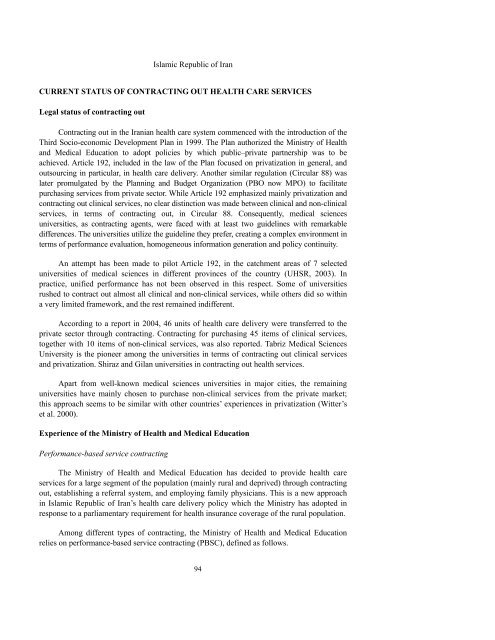The role of contractual arrangements in improving health sector ...
The role of contractual arrangements in improving health sector ...
The role of contractual arrangements in improving health sector ...
You also want an ePaper? Increase the reach of your titles
YUMPU automatically turns print PDFs into web optimized ePapers that Google loves.
Islamic Republic <strong>of</strong> Iran<br />
CURRENT STATUS OF CONTRACTING OUT HEALTH CARE SERVICES<br />
Legal status <strong>of</strong> contract<strong>in</strong>g out<br />
Contract<strong>in</strong>g out <strong>in</strong> the Iranian <strong>health</strong> care system commenced with the <strong>in</strong>troduction <strong>of</strong> the<br />
Third Socio-economic Development Plan <strong>in</strong> 1999. <strong>The</strong> Plan authorized the M<strong>in</strong>istry <strong>of</strong> Health<br />
and Medical Education to adopt policies by which public–private partnership was to be<br />
achieved. Article 192, <strong>in</strong>cluded <strong>in</strong> the law <strong>of</strong> the Plan focused on privatization <strong>in</strong> general, and<br />
outsourc<strong>in</strong>g <strong>in</strong> particular, <strong>in</strong> <strong>health</strong> care delivery. Another similar regulation (Circular 88) was<br />
later promulgated by the Plann<strong>in</strong>g and Budget Organization (PBO now MPO) to facilitate<br />
purchas<strong>in</strong>g services from private <strong>sector</strong>. While Article 192 emphasized ma<strong>in</strong>ly privatization and<br />
contract<strong>in</strong>g out cl<strong>in</strong>ical services, no clear dist<strong>in</strong>ction was made between cl<strong>in</strong>ical and non-cl<strong>in</strong>ical<br />
services, <strong>in</strong> terms <strong>of</strong> contract<strong>in</strong>g out, <strong>in</strong> Circular 88. Consequently, medical sciences<br />
universities, as contract<strong>in</strong>g agents, were faced with at least two guidel<strong>in</strong>es with remarkable<br />
differences. <strong>The</strong> universities utilize the guidel<strong>in</strong>e they prefer, creat<strong>in</strong>g a complex environment <strong>in</strong><br />
terms <strong>of</strong> performance evaluation, homogeneous <strong>in</strong>formation generation and policy cont<strong>in</strong>uity.<br />
An attempt has been made to pilot Article 192, <strong>in</strong> the catchment areas <strong>of</strong> 7 selected<br />
universities <strong>of</strong> medical sciences <strong>in</strong> different prov<strong>in</strong>ces <strong>of</strong> the country (UHSR, 2003). In<br />
practice, unified performance has not been observed <strong>in</strong> this respect. Some <strong>of</strong> universities<br />
rushed to contract out almost all cl<strong>in</strong>ical and non-cl<strong>in</strong>ical services, while others did so with<strong>in</strong><br />
a very limited framework, and the rest rema<strong>in</strong>ed <strong>in</strong>different.<br />
Accord<strong>in</strong>g to a report <strong>in</strong> 2004, 46 units <strong>of</strong> <strong>health</strong> care delivery were transferred to the<br />
private <strong>sector</strong> through contract<strong>in</strong>g. Contract<strong>in</strong>g for purchas<strong>in</strong>g 45 items <strong>of</strong> cl<strong>in</strong>ical services,<br />
together with 10 items <strong>of</strong> non-cl<strong>in</strong>ical services, was also reported. Tabriz Medical Sciences<br />
University is the pioneer among the universities <strong>in</strong> terms <strong>of</strong> contract<strong>in</strong>g out cl<strong>in</strong>ical services<br />
and privatization. Shiraz and Gilan universities <strong>in</strong> contract<strong>in</strong>g out <strong>health</strong> services.<br />
Apart from well-known medical sciences universities <strong>in</strong> major cities, the rema<strong>in</strong><strong>in</strong>g<br />
universities have ma<strong>in</strong>ly chosen to purchase non-cl<strong>in</strong>ical services from the private market;<br />
this approach seems to be similar with other countries’ experiences <strong>in</strong> privatization (Witter’s<br />
et al. 2000).<br />
Experience <strong>of</strong> the M<strong>in</strong>istry <strong>of</strong> Health and Medical Education<br />
Performance-based service contract<strong>in</strong>g<br />
<strong>The</strong> M<strong>in</strong>istry <strong>of</strong> Health and Medical Education has decided to provide <strong>health</strong> care<br />
services for a large segment <strong>of</strong> the population (ma<strong>in</strong>ly rural and deprived) through contract<strong>in</strong>g<br />
out, establish<strong>in</strong>g a referral system, and employ<strong>in</strong>g family physicians. This is a new approach<br />
<strong>in</strong> Islamic Republic <strong>of</strong> Iran’s <strong>health</strong> care delivery policy which the M<strong>in</strong>istry has adopted <strong>in</strong><br />
response to a parliamentary requirement for <strong>health</strong> <strong>in</strong>surance coverage <strong>of</strong> the rural population.<br />
Among different types <strong>of</strong> contract<strong>in</strong>g, the M<strong>in</strong>istry <strong>of</strong> Health and Medical Education<br />
relies on performance-based service contract<strong>in</strong>g (PBSC), def<strong>in</strong>ed as follows.<br />
94
















